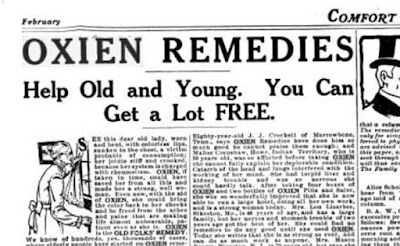Augusta in 1907
Maine's capital city had, according to magazine historian Frank Luther Mott, "the doubtful glory of being the home of the mail-order papers." The glory was doubtful because the periodicals were an advertising medium thinly disguised as literary magazines. Chief among them was Comfort,
America's most popular magazine between 1892 and 1905.
Comfort, 1896
1892 ad for Oxien, sold through the mail in pill form to be dissolved in water.
What do you suppose was in Oxien to make you feel peppier?
Vickery & Hill, Augusta
The Vickery & Hill building remains.
Comfort's offices at 20-26 Willow Street were demolished in the 1980s.
How was one to differentiate a legitimate magazine from newsprint containing advice, letters to the editor and fiction framing the ads? One criterion was the subscription fee. A magazine like Harper's or the Atlantic Monthly charged an annual cost. Comfort and other Augusta periodicals, such as Happy Hours and Golden Moments, charged a nominal fee that was rarely collected. The magazines were essentially free because income, a good deal of income, returned to the publishers in orders for health tonics and novelties.
1892
Gannett, E.C. Allen, and Vickery & Hill who all made fortunes in Augusta with this format, were most interested in increasing their mailing lists. Gannett realized he could reward readers who sent him their friends' addresses with premiums. Always savvy as to trends, he saw the nationwide craze for silk patchwork and began buying small remnants from a necktie factory. His wife Sadie N. Hill Gannett and son Guy packaged the remnants for a premium called "Sadie's Silken Shower of Satin Samples." Women were glad to trade subscription lists for free fabric, and many also mailed orders for Oxien, which promised to "Cure Drunkards and make weak women walk."
Readers were glad to enter "contests" and send in content that editors could
work up into pages around the ads.
The Maine magazines rarely paid for articles. Most content was written by readers who entered fiction contests, wrote letters to "clubs" asking and giving advice, and were pleased to see their poetry in print. The "legitimate" press looked down at the twenty or so mail-order magazines that made Augusta one of the country's largest post offices.
Magazine historians who dismissed the "Maine Magazines" could not see the impact they had in the lives of the women who read them and contributed to them.
Comfort may not have been the Atlantic Monthly but it served a devoted audience.
Gannett claimed over a million and a quarter readers in 1906, the first magazine
to boast over a million readers.
Congress attributed Post Office debt to the volume of the subsidized newsprint being mailed out of Augusta and passed a 1907 law decreeing that a legitimate magazine must have a pre-paid, audited subscription list.
William Howard Gannett 1854 - 1848
Unable to afford mailing at first-class rates, most of the Maine magazines went out of business that year. Gannett decided Comfort had a following loyal enough to actually pay to receive it, and the format changed to look more like a legitimate magazine.
1913
Comfort continued through 1940 when Vickery & Hill's Needlecraft Magazine absorbed it. The Gannett family branched out into newspapers where they became quite successful in Maine, but they are not the same family as the other Gannett publishing empire, founded by a New Yorker.
Chestnut Burr design of red and green sent by Mrs. M.P. Williams, Texas.
From its beginnings at the kitchen table, quilts were a feature. Premiums included quilt patterns and kits as well as fabric.
The readers' exchange columns featured drawings and photographs of completed blocks. Editors, primarily with the byline Mrs. Wheeler Wilkinson and a few others like Mollie Millard, organized the columns giving a few pattern names and minimal color suggestions.
The Comfort quilt patterns featured many appliqué designs, so they are a good source up into the 1920s of vernacular patterns that many other periodicals ignored.
Patterns were reprinted in a 1921-1922 booklet Comfort's Applique and Patchwork by Mrs. Wilkinson.
We'd like to know more about Mrs. Wheeler Wilkinson but she remains elusive---a fictional editor or a pen name?
More tomorrow.
Washington Lily
published in April, 1923,
one of the winners in a reader contest.
A Washington Lily---pink and yellow
Quilt from Kathy Sullivan's collection. I'd have dated
this as 1880-1920 until I realized Comfort's influence.
It's likely after 1923.
Collection of the American/International Quilt Association
"Dark blue for the vases"
Online auction
Perhaps influenced by the Washington Lily
The Comfort quilt patterns featured many appliqué designs, so they are a good source up into the 1920s of vernacular patterns that many other periodicals ignored.
1922 ad
Patterns were reprinted in a 1921-1922 booklet Comfort's Applique and Patchwork by Mrs. Wilkinson.
Were people like "Janie Becker" free lance writers,
reader contributors or Comfort employees?
We'd like to know more about Mrs. Wheeler Wilkinson but she remains elusive---a fictional editor or a pen name?
More tomorrow.

























My grandmother and great-aunt worked for Vickery-Hill in Augusta, Maine.....probably in the teens and 1920's.
ReplyDeleteThank you for an interesting read on a Sunday morning. Looking forward to more.
ReplyDeleteThe older I get the more interesting I find history! Thank you for helping fill in gaps as I read your posts, Barbara!
ReplyDeleteThis comment has been removed by a blog administrator.
ReplyDelete